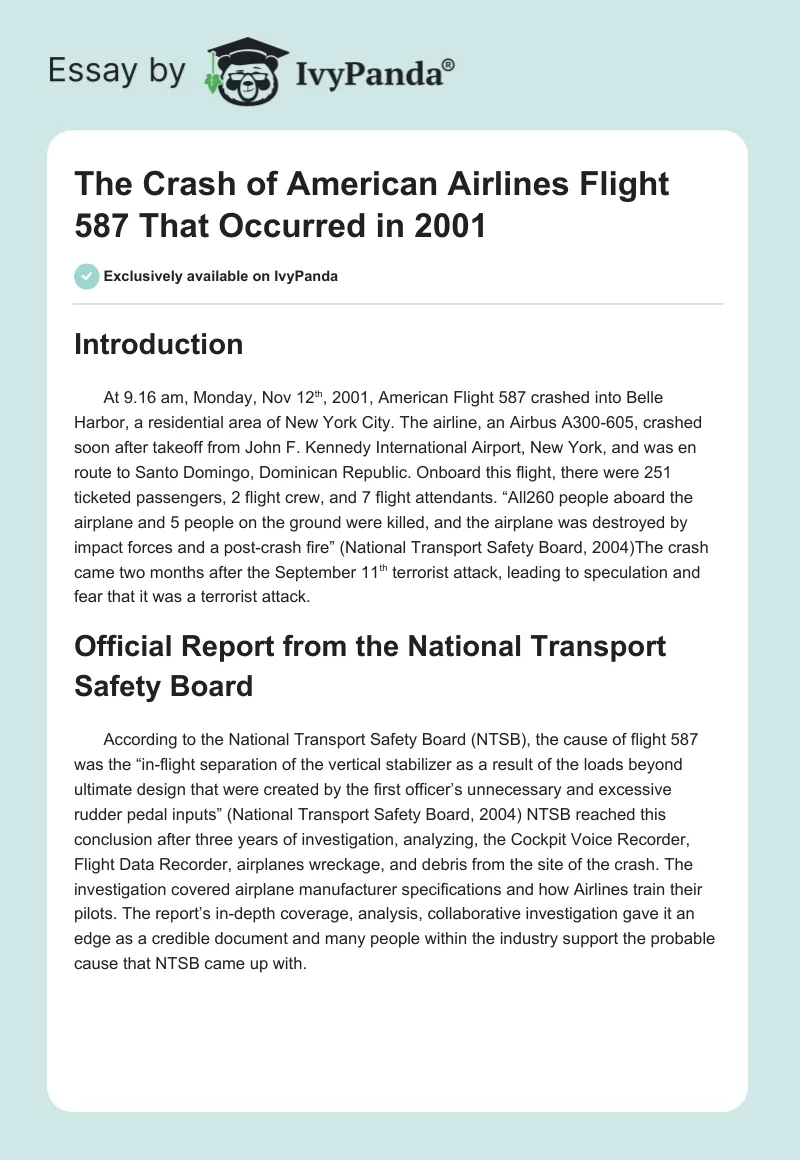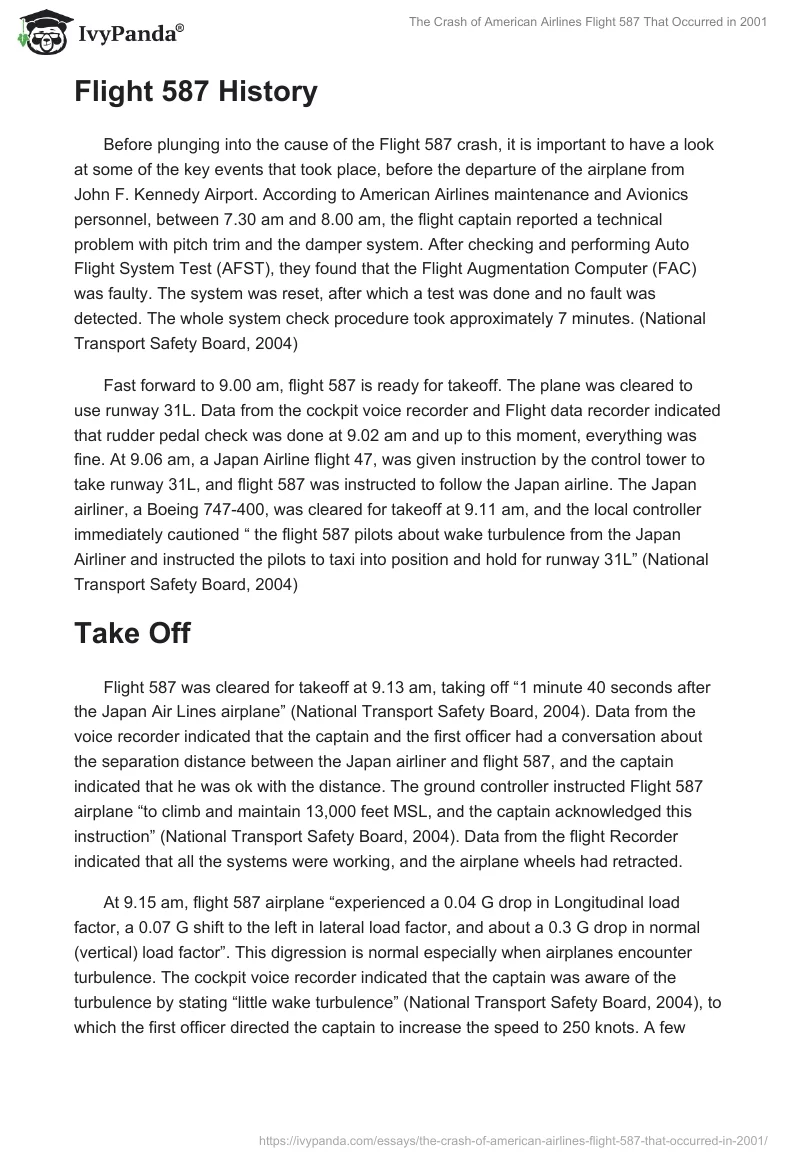Introduction
At 9.16 am, Monday, Nov 12th, 2001, American Flight 587 crashed into Belle Harbor, a residential area of New York City. The airline, an Airbus A300-605, crashed soon after takeoff from John F. Kennedy International Airport, New York, and was en route to Santo Domingo, Dominican Republic. Onboard this flight, there were 251 ticketed passengers, 2 flight crew, and 7 flight attendants. “All260 people aboard the airplane and 5 people on the ground were killed, and the airplane was destroyed by impact forces and a post-crash fire” (National Transport Safety Board, 2004)The crash came two months after the September 11th terrorist attack, leading to speculation and fear that it was a terrorist attack.
Official Report from the National Transport Safety Board
According to the National Transport Safety Board (NTSB), the cause of flight 587 was the “in-flight separation of the vertical stabilizer as a result of the loads beyond ultimate design that were created by the first officer’s unnecessary and excessive rudder pedal inputs” (National Transport Safety Board, 2004) NTSB reached this conclusion after three years of investigation, analyzing, the Cockpit Voice Recorder, Flight Data Recorder, airplanes wreckage, and debris from the site of the crash. The investigation covered airplane manufacturer specifications and how Airlines train their pilots. The report’s in-depth coverage, analysis, collaborative investigation gave it an edge as a credible document and many people within the industry support the probable cause that NTSB came up with.
Flight 587 History
Before plunging into the cause of the Flight 587 crash, it is important to have a look at some of the key events that took place, before the departure of the airplane from John F. Kennedy Airport. According to American Airlines maintenance and Avionics personnel, between 7.30 am and 8.00 am, the flight captain reported a technical problem with pitch trim and the damper system. After checking and performing Auto Flight System Test (AFST), they found that the Flight Augmentation Computer (FAC) was faulty. The system was reset, after which a test was done and no fault was detected. The whole system check procedure took approximately 7 minutes. (National Transport Safety Board, 2004)
Fast forward to 9.00 am, flight 587 is ready for takeoff. The plane was cleared to use runway 31L. Data from the cockpit voice recorder and Flight data recorder indicated that rudder pedal check was done at 9.02 am and up to this moment, everything was fine. At 9.06 am, a Japan Airline flight 47, was given instruction by the control tower to take runway 31L, and flight 587 was instructed to follow the Japan airline. The Japan airliner, a Boeing 747-400, was cleared for takeoff at 9.11 am, and the local controller immediately cautioned “ the flight 587 pilots about wake turbulence from the Japan Airliner and instructed the pilots to taxi into position and hold for runway 31L” (National Transport Safety Board, 2004)
Take Off
Flight 587 was cleared for takeoff at 9.13 am, taking off “1 minute 40 seconds after the Japan Air Lines airplane” (National Transport Safety Board, 2004). Data from the voice recorder indicated that the captain and the first officer had a conversation about the separation distance between the Japan airliner and flight 587, and the captain indicated that he was ok with the distance. The ground controller instructed Flight 587 airplane “to climb and maintain 13,000 feet MSL, and the captain acknowledged this instruction” (National Transport Safety Board, 2004). Data from the flight Recorder indicated that all the systems were working, and the airplane wheels had retracted.
At 9.15 am, flight 587 airplane “experienced a 0.04 G drop in Longitudinal load factor, a 0.07 G shift to the left in lateral load factor, and about a 0.3 G drop in normal (vertical) load factor”. This digression is normal especially when airplanes encounter turbulence. The cockpit voice recorder indicated that the captain was aware of the turbulence by stating “little wake turbulence” (National Transport Safety Board, 2004), to which the first officer directed the captain to increase the speed to 250 knots. A few seconds later The Flight Data Recorder recorded inconsistent movement of rudder pedals, control column, and control wheels.
Traveling at 240 knots, at exactly 9.15:52-53, the cockpit voice recorder recorded clicking and thumping sounds, followed by the strained voice of the first officer asking the captain to put the airplane to max power. 4 seconds later, the CVR recorded a loud thump. Accompanying data indicate that at this point, “the vertical stabilizer’s right rear main attachment fitting fractured” (National Transport Safety Board, 2004) and consequently separated from the airplane. Subsequently, the CVR recorded, a loud bang, signaling the airplane crash.
Inference
After analyzing all the events that took place during the 2 minutes that flight 587 airplane was on the air, NTSB concluded that the airplane crash was caused by “in-flight separation of vertical stabilizer as a result of the loads beyond ultimate design that were created by the first officer’s unnecessary and excessive rudder pedal inputs” (National Transport Safety Board, 2004). After encountering the first turbulence, the first officer overreacted, by making “large magnitude flight control inputs, including rudder pedal inputs, to roll the airplane out of such an upset” (National Transport Safety Board, 2004). This could have been because of the pilot’s failure to understand how airplanes respond to large “rudder inputs at high airspeeds or the mechanism by which the rudder rolls a transport-category airplane” (National Transport Safety Board, 2004)
Other Theories
The crash of Flight 587 airplane could not have come at a worse time, 2 months after Sept.11 terrorist attack. There was renewed “fear that terrorists had struck again” (China Daily, 2004) Initial investigations were not ruling out terrorism or sabotage. After a thorough investigation, investigators couldn’t find any evidence to indicate that the crash was an act of terrorism. There was yet another group that speculated that one of the airplane engines caught fire. After careful examination of both engines, the investigator ruled out engine failure as the probable cause of the crash.
Recommendation
Having established the probable cause, NTSB came up with recommendations targeting airplane operators and manufacturers to launch a training program aimed at “explaining certification requirements for the rudder and vertical stabilizer on transport-category airplanes” (National Transport Safety Board, 2004) Through training, pilots will be made fully aware that a “full rudder deflection in one direction followed by a full or nearly full rudder deflection in the opposite direction, or certain combinations of sideslip angle and opposite rudder deflection can result in potentially dangerous loads on the vertical stabilizer, even at speeds below the design maneuvering speed” (National Transport Safety Board, 2004). In addition, Federal Aviation Administration (FAA) required that all airplane manufacturers revise all information that covers the operation of the rudder. This would help reinforce the training recommendation by NTSB.
Conclusion
American Airlines Flight 587 crashed in a residential area of New York, a few minutes after takeoff from John F. Kennedy International Airport. The Airplane, an Airbus A-300-605 was on route to the Dominican Republic, carrying 251 passengers, 2 flight crews, and 7 flight attendants. All those on board died on impact and 5 more people on the ground were killed. Information gathered from the Flight Data Recorder and Cockpit Voice Recorder indicates that the cause of the crash was a result of the pilot’s errors. The plane encountered turbulence caused by a Japan Airline that had just taken off, and the pilots overreacted by making excessive rudder pedal input. Although many people feared that the crash was an act of terrorism, investigators did not find any evidence linking the crash to terrorism. Further analysis of the airplane engines ruled out engine failure as the probable cause of the crash. As a result, NTBS recommended that airlines operator and manufacturer start programs to train pilots on rudder operation when an airplane experience turbulence.
References
China Daily. (2004). Pilot error blamed for Flight 587 crash. Web.
Michael James. (2010). Rudders Are For Turning. Web.
National Transport Safety Board. (2004). In-Flight Separation of Vertical Stabilizer. Washington: National Transportation Safety Board.
Time Ins. (2001). Engine Failure Believed Cause of AA Crash. Web.


